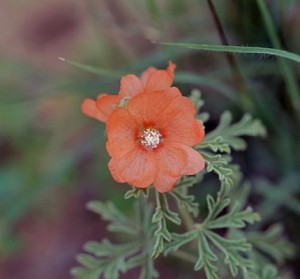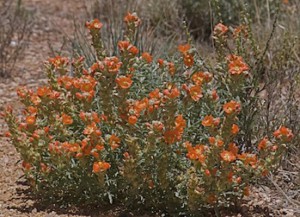Scientific name: Sphaeralcea coccinea
Common name Scarlet globemallow
Family: Malvaceae
Article by Susan Bruneni

Close up of flower and leaves of Sphaeralcea coccinea (Photo by Janice Tucker)
The small, orangish blooms and grayish foliage of the scarlet globemallow hold a unique spot in history. It is reportedly the last plant specimen collected by Meriwether Lewis on the Lewis and Clark expedition. The original specimen is on display at the Smithsonian Institute.
Sphaeralcea coccinea is a perennial plant growing four to 16 inches in height primarily spread from rhizomes. (Seeds are also produced.) The perennial lifespan is up to 35 years. Stems are grayish with dense, star-shaped hairs (to reflect solar radiation and protect against drying) and alternately arranged palmate leaves with three to five main wedge-shaped segments. The three-quarter-inch flowers are pale to reddish-orange and saucer-shaped, with five notched, broad petals. The bloom is often described as similar to hollyhocks, another member of the Malvaceae family.
Plants flower from May to October.The scarlet globemallow prefers very dry, poor soils with full sun. It is distributed widely throughout the western United States and western Canada to 48 N latitude, at elevations from: 3000 to 9,000 feet. It grows throughout Santa Fe, including the Leonora Curtin Wetlands Preserve, where it greets visitors near the parking lot and throughout the preserve.

Full plant in bloom (Photo by Janice Tucker)
This humble wayside plant features many valuable environmental attributes. In areas cleared by fire, the scarlet globemallow is the first plant to emerge. Because its rhizomes are deep underground, it is quick to provide ground cover and stabilizing properties and also flourishes on disturbed and over-grazed areas. The scarlet globemallow will decline when overtaken by grass population and may remain dormant for years, until other ground cover is removed. Reports from the 1880s marveled when the scarlet globemallow appeared mysteriously on disturbed ground where it had not been seen previously. Today, seeds are provided by the US Department of Agriculture for stabilization programs.
Scarlet globemallow forage is highly digestible and provides valuable food for grazing livestock, especially when grasses are dormant. Deer and other wildlife also graze on the plant, and birds and small animals feast on the fruit. Vitamin A and calcium content are high; magnesium and phosphorus content are low. Native Americans subsisted on the roots when other food was scarce.
The Northern Cheyenne and Dakota tribes used scarlet globemallow in their ceremonies. It was also used to rub hands to prevent scalds when removing meat from boiling water. (Please do not try this at home!)
The Dakota and Blackfoot Indians used a paste made from scarlet globemallow as a cooling agent for burns, scalds, and sores. A tea was used as a lotion for skin diseases, and a tonic to improve appetite. The Navajo used a tea for improving the taste of bitter medicinal herbs. Crushed leaves were used as a poultice for skin irritations and a shoe liner for blistered feet. Leonora Curtin wrote about similar uses of globemallows in New Mexico.
References:
http://www.usu.edu/
http://www.fs.fed.us/database/feis/plants/forb/sphcoc/all.html
www.wildflower.org
http://plants.usda.gov/plantguide


